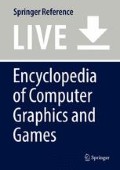References
Albornoz, E. M., Sánchez-Gutiérrez, M., Martinez-Licona, F., Rufiner, H. L. and Goddard, J.: Spoken emotion recognition using deep learning: progress in pattern recognition, image analysis, computer vision, and applications, Lecture Notes in Computer Science Vol. 8827, 104–111, (2014)
Aylett, R. and Cavazza, M.: Intelligent virtual environments – a state-of-the-art report. In Proceedings of Eurographics 2001 STARs (2001)
Aylett, R. and Luck, M.: Applying artificial intelligence to virtual reality: intelligent virtual environments. Applied Artificial Intelligence, 14 (1), 3–32, (2000).
Azcarate, A., Hageloh, F., van de Sande, K. and Valenti, R.: Automatic facial emotion recognition. University of Amsterdam, http://staff.science.uva.nl/~rvalenti/projects/mmis/Automatic%20Facial%20Emotion%20Recognition.pdf (2005)
Bacivarov, I. and Corcoran, P.M.: Facial expression modeling using component AAM models – gaming applications. Games Innovations Conference, 2009. ICE-GIC 2009. International IEEE Consumer Electronics Society’s, 1–16, (2009)
Breazeal, C.: Emotion and sociable humanoid robots. International Journal of Human-Computer Studies, 59(1–2), 119–155, (2003)
Castellano, G., Villalba, S.D. and Camurri, A.: Recognising human emotions from body movement and gesture dynamics: affective computing and intelligent interaction, Lecture Notes in Computer Science, 4738, 71–82, (2007)
Deng, L. and Dong, Y.: Deep learning methods and applications. Foundations and Trends in Signal Processing, 7(3–4), 197–387, (2013)
Egges, A., Thalmann, N. M.: Emotional communicative body animation for multiple characters. In Proceedings of the First International Workshop on Crowd Simulation, 31–40 (2005)
Egges, A., Kshirsagar, S. and Thalmann, N. M.: A model for personality and emotion simulation: knowledge-based intelligent information and engineering systems, Lecture Notes in Computer Science Vol. 2773, 453–461, (2003)
Ekman, P., Ekman, W.V. and Ellsworth, P.: What emotion categories or dimensions can observers judge from facial behavior? In: Ekman, P. (Ed.): Emotion in the Human Face, pp. 39–55, (1982)
Gilleade, K. M. and Dix, A.: Affective videogames and modes of affective gaming: assist me, challenge me, emote me. Proceedings of the 2005 DiGRA International Conference: Changing Views: Worlds in Play (2005)
Jirayucharoensak, S., Pan-Ngum, S. and Israsena, P.: EEG-based emotion recognition using deep learning networkwith principal component based covariate shift adaptation. Hindawi Publishing Corporation, Scientific World Journal, Vol. 2014, Article ID 627892 (2014)
Kaneko, K. and Okada, Y.: Facial expression system using Japanese emotional linked data built from knowledge on the web. International Journal of Space-Based and Situated Computing, Vol. 4(3–4), 165–174, (2014)
Kotsia, I., Zafeiriou, S. and Fotopoulos, S.: Affective gaming: a comprehensive survey. Computer Vision and Pattern Recognition Workshops (CVPRW), 663–670, (2013).
Li, L., Liu, G., Zhang, M., Pan, Z. and Song, E.: BAAP: a behavioral animation authoring platform for emotion driven 3D virtual characters. Entertainment Computing – ICEC 2010. Lecture Notes in Computer Science, Vol. 6243, pp. 350–357, (2010)
LISA lab, University of Montreal: Deep Learning Tutorial.http://deeplearning.net/tutorial/deeplearning.pdf (2015)
Liu, Z. and Pan, Z. G. : An emotion model of 3D virtual characters in intelligent virtual environment: affective computing and intelligent interaction, Lecture Notes in Computer Science 3784, 629–636, (2005)
Loyall, A., Reilly, W., Bates, J., Weyhrauch, P.: System for authoring highly interactive, personality-rich interactive characters. Proceedings of the 2004 ACM SIGGRAPH/Eurographics Symposium on Computer Animation, 59–68 (2004)
Martínez, H. P., Bengio, Y. and Yannakakis, G. N.: Learning deep physiological models of affect. Computational Intelligence Magazine, IEEE, 8(2), 20–33, (2013)
Min W., Ha, E. Y., Rowe, J., Mott, B. and Lester, J.: Deep learning-based goal recognition in open-ended digital games. AAAI Publications, Tenth Artificial Intelligence and Interactive Digital Entertainment Conference, (2014)
Mnih, V., Kavukcuoglu, K., Silver, D., Graves, A., Antonoglou, I., Wierstra, D. and Riedmiller, M.: Playing atari with deep reinforcement learning. NIPS Deep Learning Workshop, (2013)
Neagoe, V. E., Barar, A. P., Sebe, N. and Robitu, P.: A deep learning approach for subject independent emotion recognition from facial expressions. Recent Advances in Image, Audio and Signal Processing, 93–98, (2013)
Neverova, N., Wolf, C., Taylor, G. W. and Nebout, F.: Multi-scale deep learning for gesture detection and localization. ECCV ChaLearn Workshop on Looking at People (2014).
Ortony, A., Clore, G.L., Collins, A.: The Cognitive Structure of Emotions. Cambridge: Cambridge University Press, 15–33, (1998)
Pan, Z., Cheok, A. D., Yang, H., Zhu, J. and Shi, J.: Virtual reality and mixed reality for virtual learning environments. Journal Computers and Graphics archive 30(1), 20–28, (2006)
Parrott, W.: Emotions in Social Psychology, Psychology Press, Philadelphia, (2001)
Picard, R. W.: Affective computing. M.I.T Media Laboratory Perceptual Computing Section Technical Report No. 321, (1995)
Plutchik, R.: The nature of emotions. American Scientist, 89(4), (2001)
Popescu, A. Broekens, J. and Someren, M.V.: GAMYGDALA: an emotion engine for games. Affective Computing, IEEE Transactions on 5(1), 32–44, (2014)
Posner, J., Russell, J. A. and Peterson, B. S.: The circumplex model of affect: an integrative approach to affective neuroscience, cognitive development, and psychopathology. Dev Psychopathol. 17(3), 715–734, (2005)
Raouzaiou, A., Tsapatsoulis, N., Karpouzis, K. and Kollias, S.: Parameterized facial expression synthesis based on MPEG-4. EURASIP Journal on Applied Signal Processing Archive 10(1), 1021–1038, (2002)
Russell, S. and Norvig, P.: Artificial intelligence: a modern approach. Prentice Hall 31–52, (1995)
Smith, C. A. P., Kisiel, K. W. and Morrison, J. G.: Working through synthetic worlds. Ashgate, 226–227, (2009)
Sullivan, J. W. and Tyler, S. W.: Intelligent user interfaces. Computational Linguistics 18(3), 368–373, (1991)
Wong, H. S. and Horace H. S.: Human computer interaction. Springer Encyclopedia of Multimedia, 289–293, (2008)
Author information
Authors and Affiliations
Corresponding author
Editor information
Editors and Affiliations
Rights and permissions
Copyright information
© 2017 Springer International Publishing AG
About this entry
Cite this entry
Kaneko, K., Okada, Y. (2017). Emotion-Based 3D CG Character Behaviors. In: Lee, N. (eds) Encyclopedia of Computer Graphics and Games. Springer, Cham. https://doi.org/10.1007/978-3-319-08234-9_35-1
Download citation
DOI: https://doi.org/10.1007/978-3-319-08234-9_35-1
Received:
Accepted:
Published:
Publisher Name: Springer, Cham
Print ISBN: 978-3-319-08234-9
Online ISBN: 978-3-319-08234-9
eBook Packages: Springer Reference Computer SciencesReference Module Computer Science and Engineering

